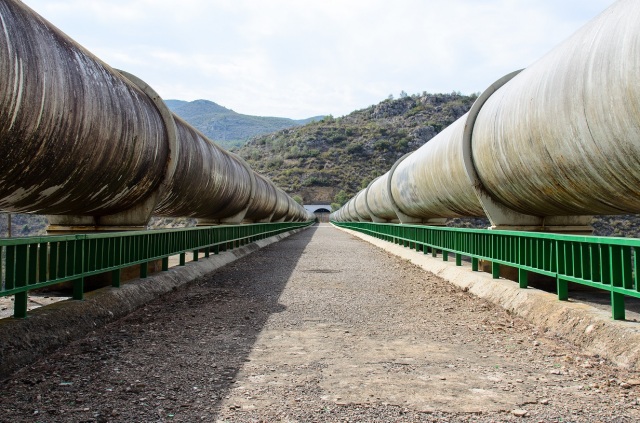How To Use Big Data In Environmental Research

Defining Large Data
Big Data was the buzz phrase of 2017, only in truth, the concept has been effectually far longer than that. Nosotros know what data is - it is the raw information nerveless from any study, but particularly in science. Information science is the written report of this information. Large Data takes this concept one footstep further; information technology is a data set of such complication that information technology would be impossible to process, examine, manipulate and nowadays using traditional methods. The intended results are frequently so complex (1) that it'southward difficult to procedure even using tried and tested electronic methods. It's of import to note that the term does not necessarily announce the size of the data prepare (although sometimes a big volume of data is unavoidable), simply information technology'south complexity. Big Information is determined using v metrics (2):
- Volume: Big Data gathers data every second. Nosotros no longer measure this data in gigabytes, not even in terabytes, merely the next stages upwardly (past the petabyte, exabyte, zettabyte and yottabyte). To put these in context, two petabytes volition hold all data from US academic research libraries and 5 exabytes volition store every word ever spoken in every human language that ever existed (3)
- Diversity: Present technologies make it possible not but to learn enormous sets of information, but also allows for diversity. Electric current storage makes it possible to larn enormous volumes in a short space of fourth dimension. For any analysis, multifariousness is as important as volume. Much of the world'due south stored information is unstructured but Big Data allows for structuring and unstructured information (2)
- Velocity: To exist relevant, Big Data must be able to cope with the speed at which data is generated in order to shop it and retain the most up-to-appointment and relevant information. This is useful in nearly areas just vital in early alarm systems alee of natural disasters (5) or in finance to find fraudulent activities (two), for example. Velocity covers speed of creation, the speed of capture, and the speed of processing (4)
- Veracity: Arguably the nigh important (just surprisingly a new addition) in science, is the need for verifiable data. This seeks to determine a information set's accuracy and integrity, non just of the data but likewise the sources that generate information technology. If there is no trust in the information source, the data itself is well-nigh useless (v)
- Value: More than concerned with the results that users excerpt from the Large Data, if we cannot make sense of the data and then it has no value (2). The exercise in capturing and storing the data will take been completely useless and the do a waste of time, money and resources
Big Information is hither to stay. It has many uses in business such every bit marketing and finance, for public policy such as crime and urban planning, and healthcare assistants and planning such as illness outbreak management and monitoring. It'due south been useful in sciences that have traditionally always required large sets of data but lacked the methods to process and use them. In genetics and ecology specially, there has always been a disparity betwixt the corporeality of data they are able to learn and store, and the processing methods that could allow them to extract the most apply from that data.
A History of Large Data
Early on Big Data Problems
If we see any attempt at storing, harnessing and making bachelor data for consumption and utilise every bit "Big Information" then information technology's arguable that the concept of Big Data goes dorsum into antiquity with the original Great Library at Alexandria (6). Information technology is believed that the facility, 1 of the 7 Great Wonders of the World, stored up to half a million scrolls. We could also argue that the world's kickoff computer, The Antikythera Mechanism used to predict astronomical events years and even decades in advance (seven), too technically qualifies every bit Big Information. Proving that you don't demand a lot of information to make sense of data, this is 1 of the earliest computers. What nosotros have here in antiquity are the two sides to Big Data from two seemingly completely different concepts - the book of storage (Not bad Library) and calculation based on the quality of evidence (Antikythera Machinery).
In the mod age (since the Enlightenment) Big Data is and has always been inextricably linked to the young scientific discipline of computing and the much older science of statistics, commencement used in Bubonic Plague prediction in Renaissance Europe (half dozen). Even before the dawn of modern computing in the 1940s did researchers begin to experience the bug of the continual and exponential aggregating of data. Bug concerning how and where to shop such data, cataloguing and indexing, and sorting the useful from the irrelevant alongside the need to ensure relevance for proper results extraction.
This is the problem that faced the US government post-obit the 1880 census. They predicted it would have eight years to procedure all the data from that census and ten years to process the 1890 data by which time the side by side census would be prepare. They hired a man called Herman Hollerith who invented a device known equally the Hollerith Tabulating Auto (eight) which used punch cards to process the data to a matter of months.
20thursday Century: The Dawn of True Computing
In the 1940s, a technical term arose that remains in common to use today "information explosion" (nine). Researchers had been aware of such problems for centuries (see the previous section) but with a rapid population increment from the Enlightenment, access to better standards of health in evidence-based medicine, it was just a matter of time. Now, and for a variety of reasons, this explosion seems never to have levelled out. Researchers, institutes, governments, even commerce have always sought more information, to make better utilise of it, and to store it in such a way as to make it useful. The 1920s saw the arrival of magnetic tape storage while Nikola Tesla theorized the arrival of wireless technology to help store this information (13).
Past 1941, the computer was five years former. Alan Turing is credited with inventing the world'southward first computational automobile in 1936 (x). Within a decade, academics were expressing concern about the expansion of data that mirrored the issues expressed in the late 19th century. Computing was able to process more data and faster, but the same problems remained - could the processing ability of the figurer historic period ever keep up with the greater need placed on it for the applications of Large Data? This would plague the burgeoning science right through the 1960s until 1965 when the Usa government established the earth's beginning ever data centre. It was set up to store tax information and criminal records (mostly fingerprint information) on magnetic tapes (11).
4 years earlier, Derek Price commented that the number of academic journals and their published work was increasing exponentially, not linearly, and by 1967 the first theory of ADC (Automatic Data Compression) was compiled every bit a method of storing such data in hereafter (12). By the 1980s, others were commenting on the potential usefulness of continued and exponential acquisition of information sets. It was suggested by many that the data increase was not simply downward to population growth and information generation, but that those holding such information did not know how to discard of obsolete data or divide "the wheat from the chaff". This trouble would plague almost every organization and torso interested in Big Data right through to the end of the century (xiii) and the emergence of the internet coupled with a new relative cheap price of storage.
Big Information in the 21st Century
The story of modern Big Information begins in the year 2000 with the interest in how much data people produce (6). The publication of a seminal paper titled "How Much Information?" (xiv) begun in the tardily 1990s, published in 2000 and updated in 2003 plant that each person produced, each year, i.5bn gigabytes. Divided up, that makes 250mb per person. Only 1 year later the first three items on the list of Five Vs (that would later form the pillars of Big Data) were defined (6). It was too the twelvemonth we began to see SaaS (Software every bit a Service), driving towards the Deject storage we have today. More exciting developments came in 2005 with the emergence of Spider web 2.0. This meant content produced by and for users of the cyberspace rather than solely past web service providers. We cannot underestimate the importance of both of these trends in pushing towards Big Data collection and processing.
With the publication of the 2010 study on "How Much Data?", it was revealed that in 2008, the internet's servers processed an center-opening 9.57 zettabytes of information. To put this in context, that amounts to nine.57 trillion gigabytes (6). Besides, information technology seemed that commerce was adapting to the continued globe in storing 200 terabytes of data each on boilerplate. But much of this would not be relevant to the boilerplate person for several years. The election campaign of President Barack Obama in 2008 was notable for many reasons; he is credited with beingness the first candidate to harness the power of the internet, especially social media, in petitioning voters. The campaign was also the first to heighten funds through "crowdsourcing".
In 2012, the reelection campaign took using the net as a tool ane stride further. Obama'south team sought re-election (and won) by harnessing Big Data and Data Analytics (14). The campaign'due south success gave validation to the science and in 2012, the administration released details of the Big Data Research and Development Initiative (15). Spread across multiple departments and programs, it seeks to improve government decision making in a wide variety of areas, especially in science and engineering in partnership with the education sector, and in commerce and industry. It was, perhaps, in response to a prediction in 2011 that the latter role of the decade would run into a massive skills shortage for people entering Data Science.
Now, in the age of Big Data, its predicted growth has arrived with the capacity to agree, store and employ information technology, recruiters await the number of openings in these roles to airship to several million globally by 2020. It is upwardly to the various regime agencies and the private sector to prepare for a new decade where Big Data is the norm rather than the exception.

How Does Environmental Sciences Employ Big Data? Real World Instance Studies
It should hardly surprise us that government bodies and academy research departments all over the globe are already using Big Data to aid enquiry and decision-making. Here is a selection of the technology of Big Data and success stories.
The EPA and Public Wellness
One of the biggest areas in the US for unifying big information with ecology scientific discipline is public and ecology health (16). Already, we've seen improvements in the monitoring and mitigation of toxicological issues of industrial chemicals released into the atmosphere. Monitoring has e'er used the tried and tested methods such as localized environmental sampling, but at present we can process such data through computational methods, the outcome is more accurate, more than up-to-date, faster produced, with more analytical data to allow experts to make an informed decision. Large Information allows for high throughput (more resource, a longer menstruum of time), combined information sets (bringing together multiple, otherwise seemingly disparate information sets) and meta-assay (studies that are the compilation of existing studies to create a more than thorough and hopefully accurate moving picture), and deeper analysis of the results produced from these studies.
EPA is presently using such data acquired through Big Data Analytics to synthesize more than authentic predictions for areas where data either does not exist or is difficult to larn. Also, researchers can identify gaps in the information and potential vulnerabilities in the system and process of investigation. Overall, this mitigates the problems and enhances data for amend decision making for public health concerns. They are now working with NCDS (National Consortium for Data Science) to identify electric current challenges that they promise to address through large data science (16).
For Geographic Data
Few tools take proven every bit useful to and so many environmental sciences as the map. From simple cartography for naval navigation, geographic surveying, to modern uses for Geographic Information Systems (databases of data sets from which we can produce digestible maps and create visually striking imagery for an intended audition), GIS thrives on Big Data. Much of GIS force lies in its ability to consolidate, utilize and nowadays statistical data. The more data you accept from a geographic expanse, the amend the quality of the output and the more informed the decision making is likely to be. Its biggest contribution (so far) seems to exist in spatial analytics, and that's practiced news for GIS technicians and for those people charged with making decisions based on the outputs of their data.
One case is in disaster and emergency relief (17). As recently as 2017, a researcher showed in a seminal written report that it would be possible in future to parse textual references to GIS databases for up-to-the-minute trouble areas currently suffering from tsunamis, flooding, and earthquakes. This would not have been possible before due to the sheer intensity of cross-referencing requirements. Satellite data and aerial imagery have already informed GIS in disaster management, with Hurricane Katrina being one of the first and best-known choices in using the technology. In time to come, Big Data volition further enhance its efficacy.
Further, the EPA is using geographic information to inform research into public wellness through the Ecology Quality Alphabetize (16). Big Data is informing a number of areas and bringing them together in the almost comprehensive analysis of its kind examining air, h2o, and dry land, and the built environment and socio-economic data (xviii). It is expected that this information will inform public health decisions and let for medical inquiry into wellness disparities of child mortality and poverty.
Climate change and Planetary Monitoring
In 2013, the United kingdom regime appear large-calibration investment in Big Data infrastructure for science, particularly in the environmental sector. Of particular note to global research was a commitment to maintaining funding for a program called CEMS (Climate and Environmental Monitoring from Infinite) (19). This allowed for the cosmos of larger databases to cope with the upcoming Big Information revolution and to let enquiry partner organizations to work with more than data and produce more results. With a specific focus on climatic change and planetary monitoring, CEMS storage removed the need to download enormous data sets while reducing the cost of access (twenty). It provides the tools as well as the data, allowing for greater efficiency, sharing in the academic community, and providing resources in one case across the reach of many institutes due to monetary restrictions alone. Along with Cloud information, this is at present the standard globally for some of the globe's top enquiry institutes.
At the aforementioned time, ane of the Britain's pinnacle universities appear plans to open up a Large Information center for environmental science research and analysis. It intends to bridge the "data gap" betwixt those who research global environmental problems and those charged with making decisions to remedy such issues (21). That's also at the core of the relationship between the Usa-based Lighthill Risk Network - an insurance representative organization - and the UK's Plant for Environmental Analytics - a data research system. Working in partnership to meet how big information tin be practical to a variety of issues in risk direction and natural disasters, specially in low-cal of increased frequency of erratic and extreme weather condition, Lighthill is now committed to developing global databases and making the business instance for sharing data (22). Such cross-government and partnerships between industry and government are working as shown with the previously discussed EPA programs and the EU-wide Copernicus Climate Alter Service which recently went live.
Finally, there are immense implications for the uses of Big Data for climate modeling. As early as 2010, NASA was utilizing Large Data capture and storage for creating climate models to make the well-nigh accurate climate projection models nevertheless (thirty). It is estimated the agency stores every bit much every bit 32 petabytes of information for modeling purposes. Models thrive on enormous information sets, circuitous information and accumulated metadata. Every bit far equally the sciences are concerned, climate modeling could exist the single most important area of academia for Big Data applications. Larn more about the history of climate change.
Agritech
With an ever-growing global population putting more pressure on resource, agritech is going to have to invest in some important developments. Information technology'south projected that barring major disaster, the global population in 2060 will be 9 billion (23, p401) with the highest growth in poorer countries. This ways a lot of investment in agricultural systems to cope. One of these is GM technology, expected to help the world's poorest communities abound resilient crops for sustainable food supply and economies. However, GM alone is not going to solve this problem.
Essential resource management plans will need to exist put into place to ensure we are making the most of agricultural state and finer using ground nutrients, limiting deforestation, properly managing water resource and developing new methods of farming that could employ even less space than earlier. In the U.s., some notable agricultural organizations are already using crowdsourced data in conjunction with remote sensing and publicly available data such every bit weather forecast information (23, p402). This allows the creation of Big Data sets so domestic farmers tin can improve land utilize efficiency, maximizing productivity and revenue stream. Here, Big Information is used in environmental engineering to inform farmer what crops they should plant this yr and even the likely event of when their machinery will interruption downwardly. This information may be used for crop management in the first instance (to cope with predicted extreme weather) or club parts ahead of time so that work is not lost in the 2d.
This is expected to be even more than of import in the developing globe for people who live in so-called "marginal landscapes" (29). This is where the agronomical growth production is depression due to erratic h2o supply, low precipitation, located in especially acidic or alkaline soils. Some people have had to use such landscapes through little choice; they may exist bad choices, but they are nonetheless the all-time bachelor to them. The use of Large Information here is two-fold: firstly, providing mitigation and direction tools for marginal landscapes already in use. Second, identifying the all-time uses for marginal landscapes non already turned over to agriculture (24).

Genetic Studies
Although non technically an environmental science, it has many uses beneficial to the environs from GM engineering science to cistron mapping, examination of the spread and transmission of infectious diseases in vital food crops such equally Panama Illness in bananas (25). It's useful in a wide range of biological sciences. Nosotros expect many advances in genetics to come up thank you to the appearance of Big Data. When the human genome was decoded in the early part of the last decade, the process took over 10 years. At present, with Big Data analytics, OECD estimates that the exact aforementioned process, if carried out for the first fourth dimension today, would take just 24 hours (26). Faster research of genetic structures means faster reaction and identification to problematic genes and faster implementation for mitigation measures.
Citizen Science
I of the unexpected benefits of Big Data to whatsoever science, but particularly the surround is so-called "Citizen Science". This is the accumulation of data reported from people in geographic locations all over the world voluntarily offering information on conditions where they live. It is often across the financial and fourth dimension resources of researchers to investigate all claims directly, so they rely on local people to report such information. This is non new, simply the term "citizen science" and the overt public engagement is new. Indeed, there are many examples of successful denizen science projects already such as the Christmas Bird Demography of 1900 (27) and that came long earlier global communication, cloud storage and mobile technology - arguably the 3 technologies that have enabled public appointment similar no other.
When many people report phenomena, it reduces the possibility of hoax, misinterpretation and faux reporting. While anecdotal evidence is non useful in some areas and, indeed counterproductive in others, science organizations all over the globe are inviting input from interested amateurs and stoking involvement in ecology science. The Christmas Bird Census may have been built-in out of collective horror of the mass slaughter of native North American birds, merely it did raise consciousness subsequently of the potential ecological problems of such a "tradition" and how citizen themselves could assist with conservation if engaged in the correct fashion. Even widespread voluntary human being drug trials for new pharmaceuticals can be considered "citizen science" with volunteers in a wide range of lifestyles engaging in experiments and reporting side furnishings and furnishings on medical weather condition back to researchers (28).
Anthropology & Archeology
The study of people in the past (and their material remains) may non be the first outlet you might consider for Big Data application, mostly because they tend to study small groups of individuals on specific sites. However, compiling such data can have benefits to studies over large areas to determine the spread of engineering, cultural evolution, and even track the spread of ancient farming practices such equally slash and fire. Accumulated digital data is non new to these 2 areas. Statistics are and have ever been a useful tool in such methods as aerial survey information and remote sensing, both of which are profoundly useful to relatively new technologist such as GIS (Geographic Information Systems) (31). In 2017, it was suggested that Big Information could exist used to plough through old excavation reports to "data mine" in a hope of extracting new data.
Archaeologists and anthropologists often bargain with complex data, comparison site analyses and trying to marry upwardly otherwise seemingly disparate information sets. In theory, this could brand big-calibration investigations into the affairs of humans in the by much faster, broader and more complex. This should result in more complex and useful results, improved visualizations, greater calculating ability and more than informed/useful results in cultural studies (32). This can exist just as useful in studying modernistic populations every bit for societies in the past. Learn more most archaeology.

In Environmental Conservation
Information technology was reported in 2014 that Big Data was not yet office of the world of sustainability and environmental conservation (33). Although some applications have proven useful in climate science and climate modelling, at that place are still few areas where Big Data is useful in such areas equally land conservation, sustainability and local ecology mitigation. The seminal report did go on to admit a number of essential areas that could (in theory) benefit from the application of Big Data and Big Data Analytics in the future (33, p7). These included:
- Environmental NGOs may use data every bit testify for lobbying governments to instigate laws or other measures to protect individual landscapes. Equally these groups are often at the forefront of advocacy because they are at the forefront of awarding, they produce the data and could use information technology in back up of their findings
- 3rd-political party specialists and consultants who tin accumulate data and provide such information in reports for clients, similar work to the NGOs noted in the offset point
- Corporate entities may employ Big Information in two forms: firstly as testify that they are complying with government regulation pertaining to their manufacture and sector; secondly to launch investigations into issues to determine the cause of an ecology problem
- International organizations who work in environmental policy research to make recommendations to other international decision-making organizations and foyer groups
- Government bodies in determining policy and bills on ecology regulation and sustainability. At nowadays, the US is working with the Dutch government in ensuring open up data policy for Large Data analytics in this expanse
In Regional Planning
Urban landscapes are often overlooked when discussing environmental sciences. But urban centers are environments likewise, sometimes with their own ecosystems. They are a curious ecology, impact the environment, are impacted the environs, providing life and work for residents and condign self-contained ecological islands. Yet studies in urbanism stand for some of the best and earliest examples of the awarding of Big Data. In 2014, a report on China's practical statistics and Big Data to examine urban systems and urban-rural planning highlighted the project (begun in the year 2000) every bit a major success (34). 2014 was the yr they engaged in rapid expansion of the practise. It requires a unification of information between information technologists, geographers, logistics and urban planning.
Big Information can be applied to examine bug areas for traffic (and aid decision making on where to identify new roads), crime centers (and where to focus law enforcement resources), wellness problems (and to attempt to understand why certain areas experience certain health bug - pollution, poverty, poor access to resource etc). Standard data sets are insufficient, lacking depth, and urban planning requires information from disparate sources - demographics, geographic information, resources, employment figures, pollution, employment, health and many more to understand the complex parts that become into making an urban heart part.
Large Information should improve the process of urban planning and resource allocation. In fact, information technology'due south already doing so. More than recently, studies have shown the usefulness of Big Data in planning "smart urban planning" (35) through large data sets, and the relative usefulness of doing and so in futurity. It's expected to be both a fourth dimension saver and a money saver.
What are the Advantages of Using Large Information in Environmental Sciences?
As yous can see from the above section, beyond the earth, authorities departments and university research facilities already using or preparing for large information. Few have fabricated as many strides as the U.s. EPA (Environmental Protection Agency) (16). The advantages are numerous.
Collecting, Sorting, Analyzing, Presenting Quickly
As hinted in the scenarios presented higher up, Big Information's major reward is in the chapters to collect masses of data and analyze it chop-chop; it'southward a realistic toll and resource saving tool in areas oftentimes drastically underfunded and having to cut costs. The storage capacity now exists to collect and collate; the computing power is likewise affordable to process and manipulate in any way necessary. This is most obvious in climatology, even if the community has been relatively irksome to prefer information technology (36). These 2 processes alone make Large Data vital for environmental scientific discipline presentation and accurateness.
Mistake Mitigation
How to handle errors in information, reporting, rogue information and anomalous results has been 1 of the biggest problems facing any science. When sample sizes are also minor, dissonant data can be given more importance than it deserves. Merely studies are often express by sample size alone due to resource factors. The larger a data set, the more than likely a rogue slice of information will fall in significance and non damage the overall result (37). Coupled with the cost and resource saving, environmental studies can, in theory, become larger and more thorough, producing more accurate results.
Amend Environmental Direction
This applies to urban management as our cities proceed to undergo rapid and vast changes in line with changing technology and demands of residents. In one study, the Norwegian majuscule of Oslo was able to reduce its energy consumption through the application of Big Data Analytics when examining its energy resources (38). Similarly, in Denver, predictive reporting and adventure analysis at the urban center'due south Police Departments was able to reduce serious criminal offense by around 30%. Portland in Oregon used a similar system to analyze cease light changes at intersections in social club to manage traffic flow better. After just vi years, the city eliminated 157,000 metric tonnes of CO2 emissions. Traffic flow varies every bit a city grows; what was once a sufficient stoplight pattern can change.
Better Determination Making
By sheer weight of numbers, Big Information and the belittling tools used in its processing is able to process and analyze more by data than e'er earlier. Previously, this also was limited by resources but with its increased access and availability, it is expected to permit easier presentation and reporting, delivering more than confident results and therefore, improve to help determination makers and policy evolution professionals. Scientists and government can work together more efficiently in future, not just to react to the environmental bug of today, but work with greater foresight today to make amend decisions for tomorrow.
What are the Current Challenges for Large Data in Environmental Sciences?
Big Information is not expected to be a panacea for all the earth'due south environmental problems or for inquiry or applied science in general. Nor is information technology designed to be a one-size-fits-all answer. Like any other emerging engineering, at that place are problems and limitations to keep in listen when extolling the virtues of Big Data.
Technical Limitations
Due to the complication of so-called Big Data, the method presents a number of other challenges to those who seek to larn and use information technology. For instance, the framework for each of the post-obit concepts:
- Methods for capturing data
- The chapters for storing it
- Analyzing the information when captured
- Searching, sharing and transferring during the utilization procedure
- Visualization and querying of information
- Updating the data in line with recent changes
- Data security, privacy issues and the sources of storage
May not always accept the capacity, particularly where the volume of data quickly outstrips the capacity for present computing engineering to perform whatever of the above functions. Big Information's increment is and so far, has been, exponential in growth. To keep up, hardware in all of the areas above volition need to keep up, if non exceed the necessary capacities. We must besides non underestimate the bug with human fault - wrongly entered information, poor processing due to mistakes, and interpretation of that data. The information may not prevarication, but humans can and do make mistakes.

Upstanding Limitations
In all this, information technology'southward important to remember that some sciences concern information pertaining to humans. Bug volition include problems such equally cultural sensitivities every bit in archæology and anthropology (32). Some critics are concerned that in reducing populations to Big Information information, we reduce their humanity, their individuality. However, with the improvements in disaster response time, applications in climate science, and in the enormous data processes when examining archaeological/anthropological data, it's likely that these human sciences and humanities concerned with the environment will benefit in the long-term.
Also, we must be enlightened of the legal ramification of data storage. Here in the U.s.a., HIPAA protects a patient'southward rights to their medical history. The European Marriage is introducing a set of regulations called GDPR (General Data Protection Regulation) in May 2018. This will bear on the U.s., specially researchers, scientific institutes and everyone handling Big Information from entities operating in the European Matrimony, or information relating to whatever citizen living inside a member state of the European union and EEA (39). Information technology is understood that the US government is watching closely to meet how GDPR functions and how it might adopt such a law in future. It's probable such information will receive protection with required deletion at the possessor'due south request; the ramifications for information stored about people will certainly utilize.
Lack of Widespread "Open Access"
Research institutes and businesses are often incredibly protective of their enquiry information, peculiarly where mass profitability is involved. Nevertheless there has been a motion in contempo decades to call for subscription-free public access to scientific data. Known as Open Admission, not enough strides have been made in this surface area, in some disciplines, that Large Data Analytics is not shortly experiencing its total potential and much data is restricted, meaning that - although studies can call on more than data and do more with it - there is still a large amount of data that could prove useful in ecology science, held privately with limited or no access. Although fearfulness of handing over information to competitors is part of the issue, other bug include lack of resources to do so or a lack of awareness of how useful Open Access can be (32). Together, Open Access and Large Data has the capacity to be a powerful forcefulness in research science, merely the latter is being held back by a lack of the former.
Sources
- https://www.nature.com/articles/455001a
- https://www.linkedin.com/pulse/20140306073407-64875646-large-data-the-5-vs-anybody-must-know/
- http://highscalability.com/weblog/2012/9/11/how-large-is-a-petabyte-exabyte-zettabyte-or-a-yottabyte.html
- https://www.coursera.org/learn/big-data-introduction/lecture/IIsZJ/characteristics-of-big-data-velocity
- https://www.sciencedirect.com/scientific discipline/commodity/pii/S1364815216304194
- https://www.weforum.org/calendar/2015/02/a-brief-history-of-large-data-anybody-should-read/
- http://maajournal.com/Issues/2002/Vol02-1/Full3.pdf
- https://www.demography.gov/history/world wide web/innovations/applied science/the_hollerith_tabulator.html
- https://en.oxforddictionaries.com/definition/information_explosion
- https://blogs.scientificamerican.com/guest-blog/how-alan-turing-invented-the-reckoner-age/
- https://world wide web.census.gov/history/pdf/kraus-natdatacenter.pdf
- https://dl.acm.org/citation.cfm?id=363790.363813&coll=DL&dl=GUIDE
- https://www.forbes.com/sites/gilpress/2013/05/09/a-very-curt-history-of-large-information/#79c899d165a1
- https://hbr.org/2012/eleven/2012-the-showtime-big-information-electi
- https://obamawhitehouse.archives.gov/blog/2012/03/29/big-data-big-bargain
- https://blog.epa.gov/blog/2016/10/filling-the-gaps-in-environmental-scientific discipline-with-big-information/
- http://www.nerc.air-conditioning.great britain/innovation/activities/environmentaldata/bigdatacapital/
- https://sa.catapult.org.uk/facilities/cems/
- https://www.reading.ac.uk/news-and-events/releases/PR604426.aspx
- https://lighthillrisknetwork.org/enquiry-priorities/
- http://ilsirf.org/wp-content/uploads/sites/5/2017/08/2017_WorldBank_Chapter_15.pdf
- https://onlinelibrary.wiley.com/doi/full/x.1111/gcbb.12078
- https://www.wur.nl/en/newsarticle/World-beginning-Panama-disease-resistant-Cavendish-bananas.htm
- http://www.oecd.org/sti/ieconomy/Session_3_Delort.pdf#folio=half-dozen
- https://jcom.sissa.information technology/sites/default/files/documents/JCOM_1602_2017_C05.pdf
- https://www.nesta.org.uk/digital-social-innovation/citizen-science
- https://www.israel21c.org/five-israeli-precision-ag-technologies-making-farms-smarter/
- https://www.nasa.gov/centers/goddard/news/releases/2010/ten-051.html
- https://world wide web.universiteitleiden.nl/en/news/2017/01/from-scarcity-to-affluence-large-data-in-archæology
- https://world wide web.academia.edu/14362660/Think_big_about_data_Archaeology_and_the_Big_Data_challenge
- http://www.smithschool.ox.air-conditioning.uk/publications/wpapers/workingpaper14-04.pdf
- https://www.sciencedirect.com/science/article/pii/S2226585615000217
- https://www.sciencedirect.com/science/commodity/pii/S0167739X17308993
- http://www.pnas.org/content/113/39/10729
- https://datafloq.com/read/the-ability-of-existent-time-big-information/225
- https://ico.org.united kingdom/media/for-organisations/documents/2013559/large-data-ai-ml-and-information-protection.pdf
- Author
- Recent Posts
Related Manufactures
Featured Article

Natural Gas 101: Pros & Cons
Natural gas is a fossil fuel, like oil and coal. It's formed from rust-covered organic material transformed by high temperatures and pressures over millions of years into bubbling of methyl hydride gas. Conventional sources are found in underground gas fields or...
How To Use Big Data In Environmental Research,
Source: https://www.environmentalscience.org/data-science-big-data
Posted by: nelsonenterhad.blogspot.com


0 Response to "How To Use Big Data In Environmental Research"
Post a Comment